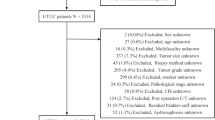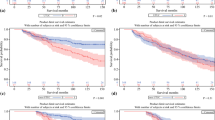Abstract
Background
Few studies have described the clinical courses and outcomes in the bladder after treatment of intravesical recurrence after radical nephroureterectomy (RNU) in patients with primary upper tract urothelial carcinoma (UTUC). We investigated the indicators for predicting subsequent bladder outcomes after treatment of intravesical recurrence after RNU.
Methods
A total of 241 patients with primary UTUC (pTa-4N0M0) who experienced intravesical recurrence after RNU were included. Of these patients, 101 (41.9 %) underwent Bacillus Calmette-Guérin treatments, whereas 49 (20.3 %) underwent intravesical chemotherapy. The median follow-up period after initial transurethral resection of the bladder tumor was 33 months. Relationships with bladder outcomes were analyzed by using multivariable analysis.
Results
Ninety-six patients experienced intravesical recurrence, and bladder progression was observed in 13. Cumulative incidence rates of intravesical recurrence at 1 and 5 years after treatment of the first intravesical recurrence were 31.0 and 48.4 %, whereas those of bladder progression at 1 and 5 years thereafter were 2.4 and 8.0 %. Multivariate analysis showed that the number of recurrent tumors and pT1 tumors at the time of the first intravesical relapse were independent risk factors for subsequent intravesical recurrence. With respect to bladder progression, multivariate analysis showed that pT1 tumors, the appearance of concomitant carcinoma-in situ at the time of the first intravesical relapse, and the absence of the Bacillus Calmette-Guérin treatment were independent risk factors.
Conclusions
This retrospective study presents a detailed picture of further bladder outcomes after intravesical recurrence after RNU in primary UTUC patients. The results may assist physicians to develop a more rational protocol in bladder surveillance.


Similar content being viewed by others
References
Siegel R, Ward E, Brawley O, Jemal A. Cancer statistics, 2011: the impact of eliminating socioeconomic and racial disparities on premature cancer deaths. CA Cancer J Clin. 2011;61:212–36.
Roupret M, Babjuk M, Comperat E, et al. European guidelines on upper tract urothelial carcinomas: 2013 update. Eur Urol. 2013;63:1059–71.
Xylinas E, Colin P, Audenet F, et al. Intravesical recurrence after radical nephroureterectomy for upper tract urothelial carcinomas: predictors and impact on subsequent oncological outcomes from a national multicenter study. World J Urol. 2013;31:61–8.
O’Brien T, Ray E, Singh R, et al. Prevention of bladder tumours after nephroureterectomy for primary upper urinary tract urothelial carcinoma: a prospective, multicentre, randomised clinical trial of a single postoperative intravesical dose of mitomycin C (the ODMIT-C Trial). Eur Urol. 2011;60:703–10.
Azemar MD, Comperat E, Richard F, et al. Bladder recurrence after surgery for upper urinary tract urothelial cell carcinoma: frequency, risk factors, and surveillance. Urol Oncol. 2011;29:130–6.
Novara G, De Marco V, Dalpiaz O, et al. Independent predictors of metachronous bladder transitional cell carcinoma (TCC) after nephroureterectomy for TCC of the upper urinary tract. BJU Int. 2008;101:1368–74.
Abe T, Shinohara N, Harabayashi T, et al. Pathological characteristics and clinical course of bladder tumour developing after nephroureterectomy. BJU Int. 2010;105:1102–6.
Tanaka N, Kikuchi E, Kanao K, et al. The predictive value of positive urine cytology for outcomes following radical nephroureterectomy in patients with primary upper tract urothelial carcinoma: a multi-institutional study. Urol Oncol. 2014;32:48.e19–26.
Kim KH, You D, Jeong IG, et al. Muscle-invasive bladder cancer developing after nephroureterectomy for upper urinary tract urothelial carcinoma. Urol Oncol. 2013;31:1643–9.
Li CC, Chang TH, Wu WJ, et al. Significant predictive factors for prognosis of primary upper urinary tract cancer after radical nephroureterectomy in Taiwanese patients. Eur Urol. 2008;54:1127–34.
Kobayashi Y, Saika T, Miyaji Y, et al. Preoperative positive urine cytology is a risk factor for subsequent development of bladder cancer after nephroureterectomy in patients with upper urinary tract urothelial carcinoma. World J Urol. 2012;30:271–5.
Takaoka E, Hinotsu S, Joraku A, et al. Pattern of intravesical recurrence after surgical treatment for urothelial cancer of the upper urinary tract: a single institutional retrospective long-term follow-up study. Int J Urol. 2010;17:623–8.
Ku JH, Choi WS, Kwak C, Kim HH. Bladder cancer after nephroureterectomy in patients with urothelial carcinoma of the upper urinary tract. Urol Oncol. 2011;29:383–7.
Kusuda Y, Miyake H, Terakawa T, et al. Gender as a significant predictor of intravesical recurrence in patients with urothelial carcinoma of the upper urinary tract following nephroureterectomy. Urol Oncol. 2013;31:899–903.
Hagiwara M, Kikuchi E, Tanaka N, et al. Impact of smoking status on bladder tumor recurrence after radical nephroureterectomy for upper tract urothelial carcinoma. J Urol. 2013;189:2062–8.
Sylvester RJ, van der Meijden AP, Oosterlinck W, et al. Predicting recurrence and progression in individual patients with stage Ta T1 bladder cancer using EORTC risk tables: a combined analysis of 2596 patients from seven EORTC trials. Eur Urol. 2006;49:466–5. discussion 475–67.
Babjuk M, Burger M, Zigeuner R, et al. EAU guidelines on non-muscle-invasive urothelial carcinoma of the bladder: update 2013. Eur Urol. 2013;64:639–53.
Harrell FE Jr, Lee KL, Mark DB. Multivariable prognostic models: issues in developing models, evaluating assumptions and adequacy, and measuring and reducing errors. Stat Med. 1996;15:361–87.
Fernandez-Gomez J, Solsona E, Unda M, et al. Prognostic factors in patients with non-muscle-invasive bladder cancer treated with bacillus Calmette-Guerin: multivariate analysis of data from four randomized CUETO trials. Eur Urol. 2008;53:992–1001.
Thomas F, Noon AP, Rubin N, et al. Comparative outcomes of primary, recurrent, and progressive high-risk non-muscle-invasive bladder cancer. Eur Urol. 2013;63:145–54.
Tanaka N, Kikuchi E, Matsumoto K, et al. Frequency of tumor recurrence: a strong predictor of stage progression in initially diagnosed nonmuscle invasive bladder cancer. J Urol. 2011;185:450–5.
Acknowledgment
Members of the Keio Collaboration Study of Urothelial Carcinoma participated in this study: Keishiro Fukumoto, Keio University School of Medicine, Tokyo; So Nakamura, Saiseikai Central Hospital, Tokyo; Yujiro Ito, Takeshi Masuda, Saitama Municipal Hospital, Saitama; Kiichiro Kodaira, Munehisa Ueno, International Medical Center-Comprehensive Cancer Center, Saitama Medical University, Saitama; Atsushi Uchida, Kyosai Tachikawa Hospital, Tokyo; Kazuhiko Nagakura, Musashino Yowakai Hospital, Tokyo; Masakazu Ohashi, Ogikubo Hospital, Tokyo; Shoji Matsuzaki, Inagi Municipal Hospital, Tokyo; Kazutoyo Miyata, Irumagawa Hospital, Saitama; and Michio Kosugi, Seiichi Iinuma, Eiju Hospital, Tokyo, Japan. This work was supported in part by Grants-in-Aid for Scientific Research (#24791671 to N. Tanaka) from the Ministry of Education, Culture, Sports, Science, and Technology of Japan. This work was also supported in part by a Keio University Grant-in-Aid for Encouragement of Young Medical Scientists (#02-002-0021 to N. Tanaka) from the Keio University School of Medicine.
Funding
The work had no specific funding or financial support.
Author information
Authors and Affiliations
Corresponding author
Rights and permissions
About this article
Cite this article
Tanaka, N., Kikuchi, E., Kanao, K. et al. Independent Predictors for Bladder Outcomes after Treatment of Intravesical Recurrence following Radical Nephroureterectomy in Patients with Primary Upper Tract Urothelial Carcinoma. Ann Surg Oncol 21, 3151–3158 (2014). https://doi.org/10.1245/s10434-014-3657-y
Received:
Published:
Issue Date:
DOI: https://doi.org/10.1245/s10434-014-3657-y




